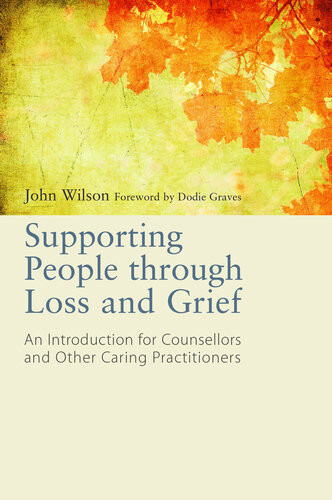

Most ebook files are in PDF format, so you can easily read them using various software such as Foxit Reader or directly on the Google Chrome browser.
Some ebook files are released by publishers in other formats such as .awz, .mobi, .epub, .fb2, etc. You may need to install specific software to read these formats on mobile/PC, such as Calibre.
Please read the tutorial at this link: https://ebookbell.com/faq
We offer FREE conversion to the popular formats you request; however, this may take some time. Therefore, right after payment, please email us, and we will try to provide the service as quickly as possible.
For some exceptional file formats or broken links (if any), please refrain from opening any disputes. Instead, email us first, and we will try to assist within a maximum of 6 hours.
EbookBell Team

5.0
110 reviews
ISBN 13: 9780857007391
Author: John Wilson
What are the different theories of grief? What skills do you need for effective counselling? How can you support people experiencing loss and grief? This handbook provides a comprehensive guide to counselling and supporting people experiencing loss and grief. It introduces the different models and theories of grief, how theory relates to practice and what the essential skills are, and how to work with people in practice. Working with families, understanding diversity and assessing clients are all covered, as well as a chapter on personal and professional development. Case studies and real life examples demonstrate skills in action, and each chapter concludes with notes for trainers. This essential guide will help all those working with people suffering loss and grief to understand grief and how to help. Counsellors, bereavement support volunteers, palliative care nurses, hospice volunteers and students in these fields will all find this an invaluable resource. It can be used as a training guide as well as a resource for individuals, both as a learning tool and for continuing professional development.
Chapter 1 The Nature of Grief
Loss disrupts the ordered narrative of our life
Working definitions
Grief in a historical account
Evidence of the universality of grief
What is grief for?
Factors affecting normal grief
The controversial nature of complicated grief
Common features of normal, healthy grief
Researchers’ arguments for and against diagnosing complicated grief
The pros and cons of a CG diagnosis
Risk factors for CG
Complicated grief and DSM-5
A professional reflection
A note for health professionals referring to a bereavement service
Summary and conclusions
Notes for trainers
Chapter 2 Theories of Grief: Historical Perspectives
The promise of science
Alexander Faulkner Shand
Sigmund Freud
Karl Abraham
Melanie Klein and the schism with Anna Freud
Erich Lindemann
George Engel
John Bowlby
The origins and development of Attachment Theory
Colin Murray Parkes
Research by Colin Murray Parkes
Summary and conclusions
Notes for trainers
Chapter 3 Attachment
The strange situation experiment
Harry Harlow’s monkeys
The ethological perspective and the ‘ghost of teleology’
Teleology versus evolution
Bowlby’s phases in the development of attachment in children
Attachment theory and the stages of grief
Notes for trainers
Chapter 4 Basic Counselling Skills: Theory into Practice
A model of counselling for loss and grief
The life of Carl Rogers
The core conditions
Some key references to Carl Rogers
Transference
Putting counselling theory into practice: active listening and how it compares with social listening
A checklist
Difficulties with listening
Active listening techniques
Working in the here-and-now: immediacy
Practising the theory: working in triads
Giving feedback to your peers
Receiving feedback
Notes for trainers
Chapter 5 Working with People Experiencing a Loss
Models of grief
Notes for trainers
Specialist interventions
Conclusions
Notes for trainers
Chapter 6 Families and Grief
What do we mean by ‘a system’?
What do we mean by ‘a family’?
Theories of family systems
Bowen’s family system approach
Family and homeostatic equilibrium
Families and attachment style
The family and differential grief
Rolland’s Family Systems-Illness Model
Types of illness
The effect of chronic disease on grief
The developmental natural history of the illness
Family belief system and culture
Rituals
Working one-to-one with the family in mind
Genograms
The buttons exercise
Implications for practice within an organization
The family sculpting exercise
Chapter 7 Working with Difference
Why it is so important to take culture into account?
What do we mean by ‘culture’?
Greater cultural differences
What is ‘working with difference’?
Practising legally, ethically and morally
The concept of ‘difference’ is a social construction
What model to use in approaching ‘working with difference?’
Recognizing difference
Universal, cultural and unique
Dangerous assumptions
Assumptions that derive from stereotyping
If in doubt, should we ask?
Finding out what your client needs
Notes for trainers
Resources
Chapter 8 Clinical Assessment in Bereavement Support
Where are assessments carried out?
Making your client feel comfortable
Hearing the client’s story
1: content of the client’s story
2a: How is the client coping with grief?
2b: Is this client ready, willing and able to use counselling effectively?
Assessing risk
Client’s risk to others
Client’s risk to self
Completing the assessment
Providing the client with feedback
What does the client want from support?
Concluding thoughts
Notes for trainers
Chapter 9 Personal and Professional Development
So you want to work with loss and grief?
The remarkable human brain
Kolb’s learning cycle
Thinking, experiencing, behaving: the TEB cycle
The role of a bodily felt shift in the TEB cycle
Learning more about ourselves 1: keeping a reflective journal
Learning more about ourselves 2: daring to receive feedback from others
Learning more about ourselves 3: drawing your lifeline
Learning more about ourselves 4: personal attitudes and beliefs about death and loss
Learning more about ourselves 5: addressing personal prejudices – attitudes to minority groups, sexuality, age, disability
Making effective use of supervision
Learning styles
A constructivist way of making sense and creating personal meaning in our world
Confidentiality
what can you do for someone grieving a loss
concept of loss grief and grieving process
effects of loss and grief
supporting loved ones through grief
supporting someone through grief
support through grief
Tags: John Wilson, Loss, Grief